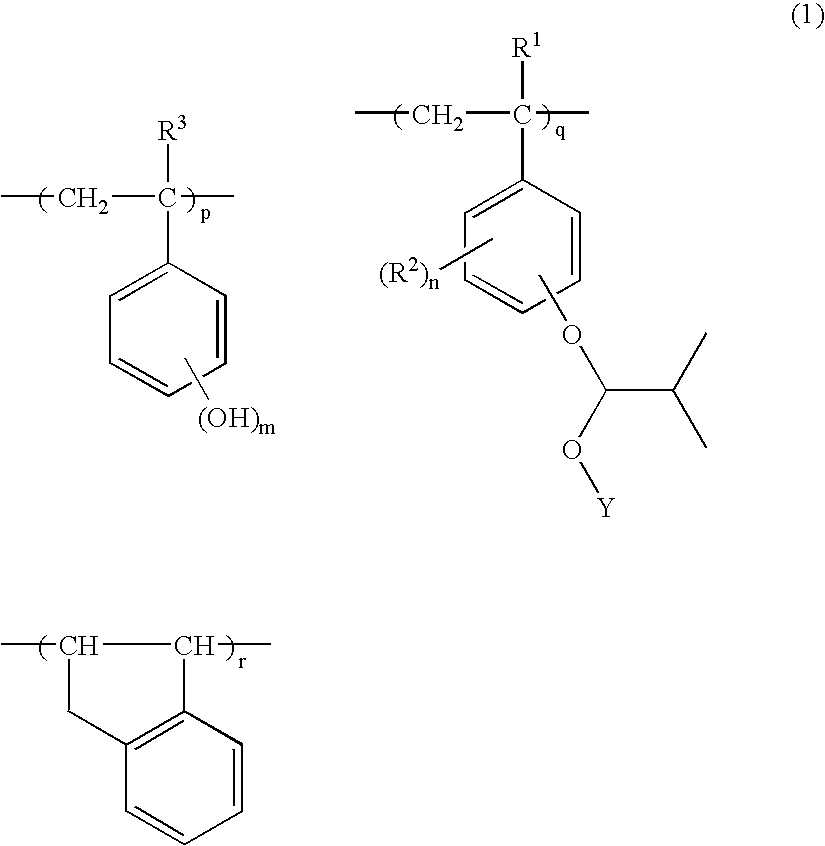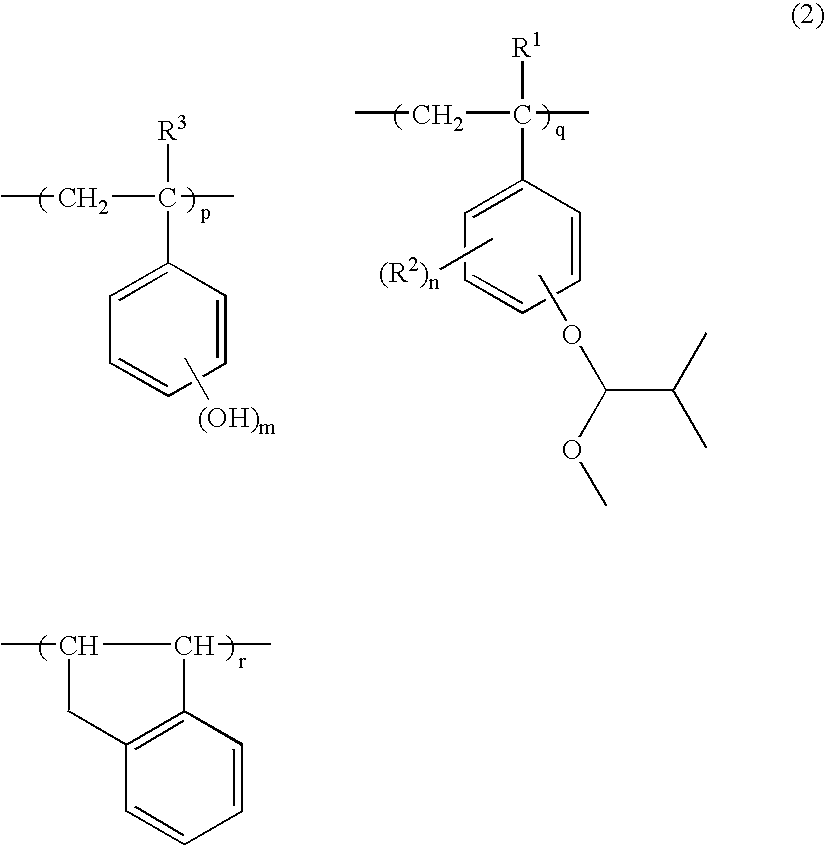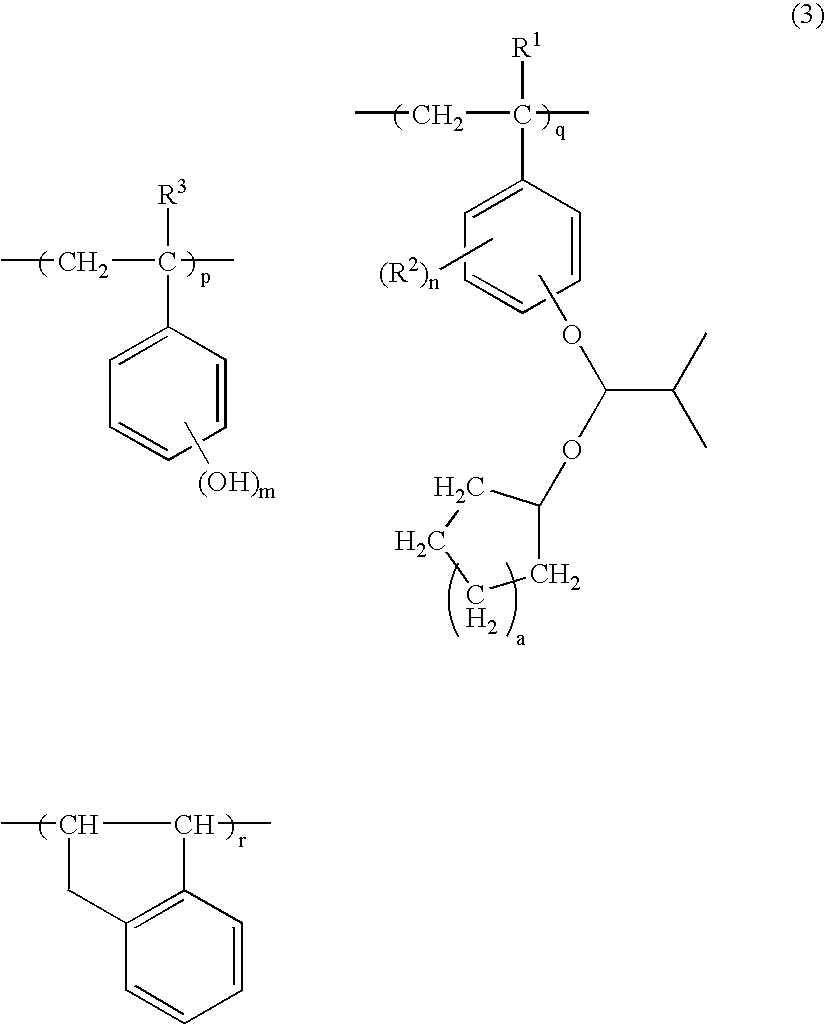Resist composition and patterning process
a composition and resist technology, applied in the field of resist composition, can solve the problems of reducing the resistance of the difficult to form a resist film to a reduced thickness compliant with a reduced feature size, and the pattern configuration is considerably narrowed, so as to achieve satisfactory resist pattern profile, increase solubility in alkali, and high resolution
- Summary
- Abstract
- Description
- Claims
- Application Information
AI Technical Summary
Benefits of technology
Problems solved by technology
Method used
Image
Examples
synthesis example 1
[0096]In a 1-L flask were admitted 270.7 g of acetoxystyrene, 129.3 g of indene, and 200 g of toluene as a solvent. The reactor was cooled to −70° C. in a nitrogen atmosphere, whereupon vacuum deaeration and nitrogen flow were repeated three times. The reactor was warmed up to room temperature, 13.7 g of AIBN was added as a polymerization initiator, and the reactor was further heated to 55° C., at which reaction was effected for 40 hours. The reaction solution was concentrated to a ½ volume and poured into 5.0 L of methanol for precipitation. The resulting white solids were filtered and vacuum dried at 40° C., obtaining 260 g of a white polymer. The polymer was dissolved in a mixture of 0.4 L methanol and 0.5 L tetrahydrofuran again, to which 140 g of triethylamine and 30 g of water were added. The reactor was heated to 60° C., allowing deprotection reaction to occur. The reaction solution was neutralized with acetic acid, concentrated, dissolved in 0.5 L of acetone, and poured into...
synthesis example 2
[0103]In a 1-L flask were admitted 306.1 g of acetoxystyrene, 93.9 g of indene, and 200 g of toluene as a solvent. The reactor was cooled to −70° C. in a nitrogen atmosphere, whereupon vacuum deaeration and nitrogen flow were repeated three times. The reactor was warmed up to room temperature, 17.7 g of AIBN was added as a polymerization initiator, and the reactor was further heated to 55° C., at which reaction was effected for 40 hours. The reaction solution was concentrated to a ½ volume and poured into 5.0 L of methanol for precipitation. The resulting white solids were filtered and vacuum dried at 40° C., obtaining 282 g of a white polymer. The polymer was dissolved in a mixture of 0.4 L methanol and 0.5 L tetrahydrofuran again, to which 140 g of triethylamine and 30 g of water were added. The reactor was heated to 60° C., allowing deprotection reaction to occur. The reaction solution was neutralized with acetic acid, concentrated, dissolved in 0.5 L of acetone, and poured into ...
synthesis example 3
[0110]In a 1-L flask were admitted 50.0 g of the hydroxystyrene-indene copolymer (Polymer 1) and 300 g of tetrahydrofuran as a solvent. The reactor was cooled to 5° C. in a nitrogen atmosphere, whereupon 31.0 g of triethylamine was added, and 12.7 g of acetalizing agent A, identified later, was added dropwise over one hour. The reactor was warmed up to room temperature, at which reaction was allowed to occur for 4 hours. The reaction solution was concentrated, dissolved in 200 g of acetone, neutralized with acetic acid, and poured into 7.0 L of water for crystallization and precipitation. The resulting white solids were filtered and dried in vacuum at 40° C., obtaining 53.5 g of a white polymer.
[0111]The polymer was analyzed by 13C-NMR, 1H-NMR and GPC, with the analytical results shown below.
[0112]Copolymer Compositional Ratio[0113]hydroxystyrene:indene:4-methoxyisobutoxystyrene=70.7:11.9:17.4[0114]Mw=15,100[0115]Mw / Mn=1.98
[0116]This polymer is designated Polymer A.
PUM
| Property | Measurement | Unit |
|---|---|---|
| feature size | aaaaa | aaaaa |
| temperature | aaaaa | aaaaa |
| molecular weight dispersity | aaaaa | aaaaa |
Abstract
Description
Claims
Application Information
 Login to View More
Login to View More - R&D
- Intellectual Property
- Life Sciences
- Materials
- Tech Scout
- Unparalleled Data Quality
- Higher Quality Content
- 60% Fewer Hallucinations
Browse by: Latest US Patents, China's latest patents, Technical Efficacy Thesaurus, Application Domain, Technology Topic, Popular Technical Reports.
© 2025 PatSnap. All rights reserved.Legal|Privacy policy|Modern Slavery Act Transparency Statement|Sitemap|About US| Contact US: help@patsnap.com



